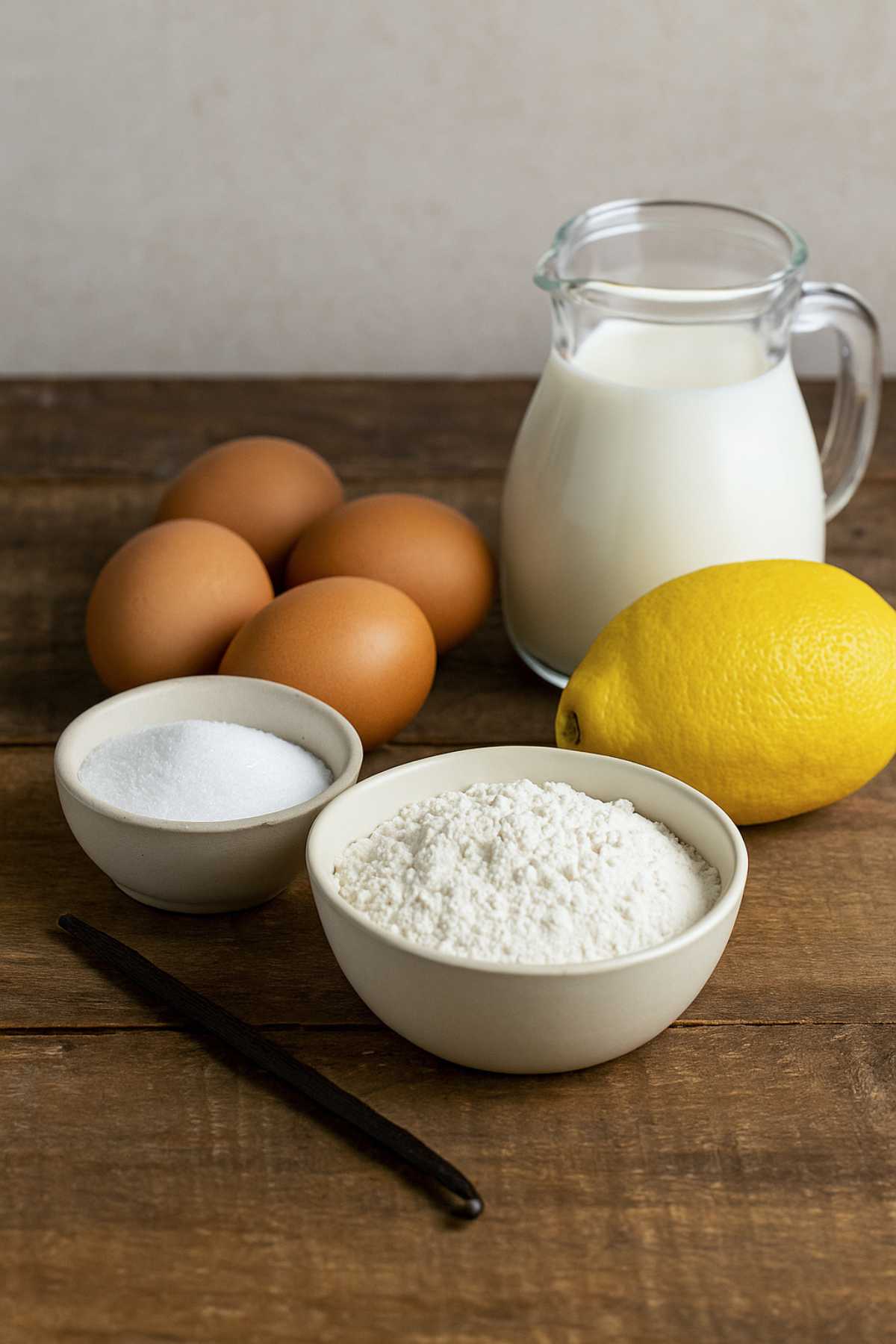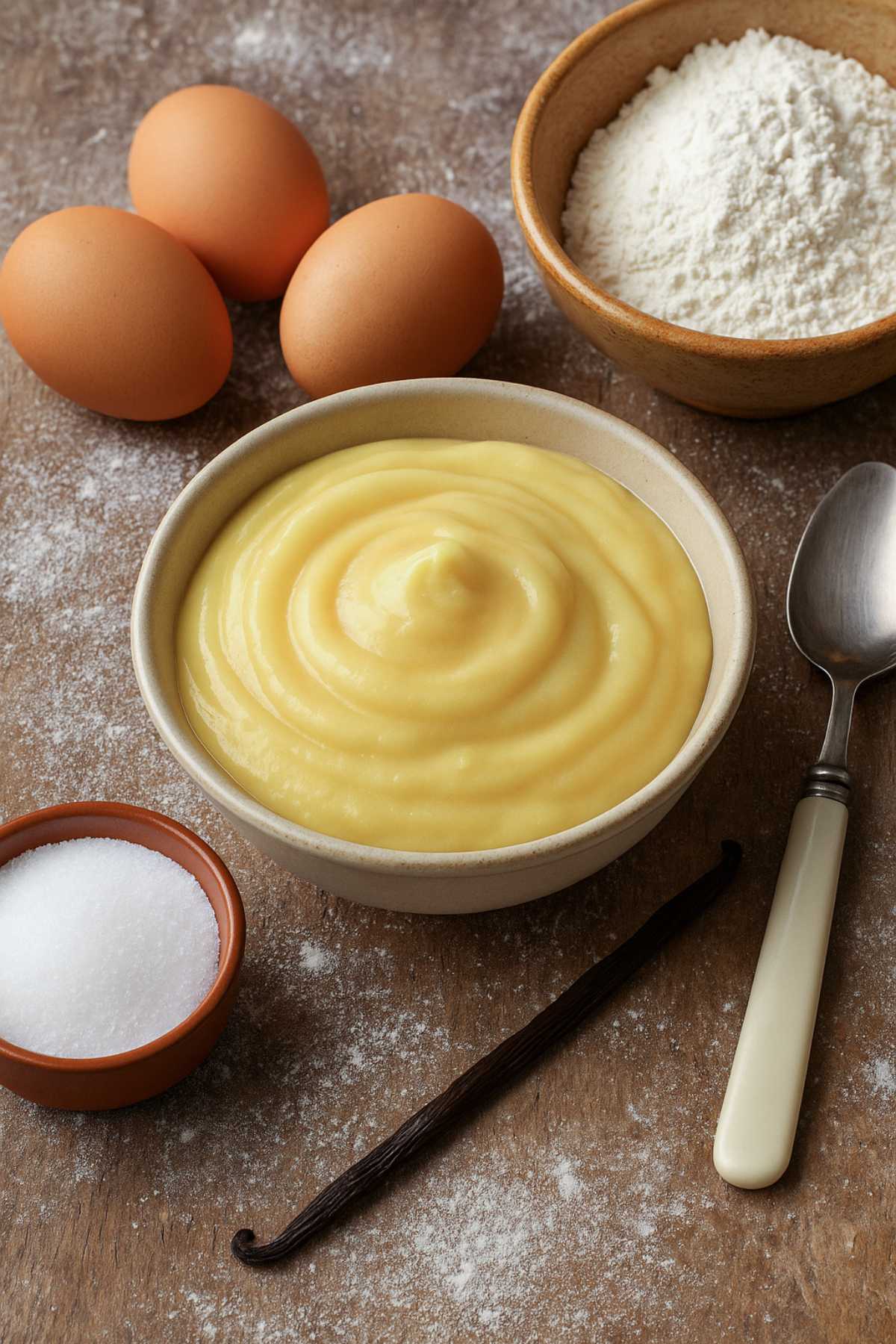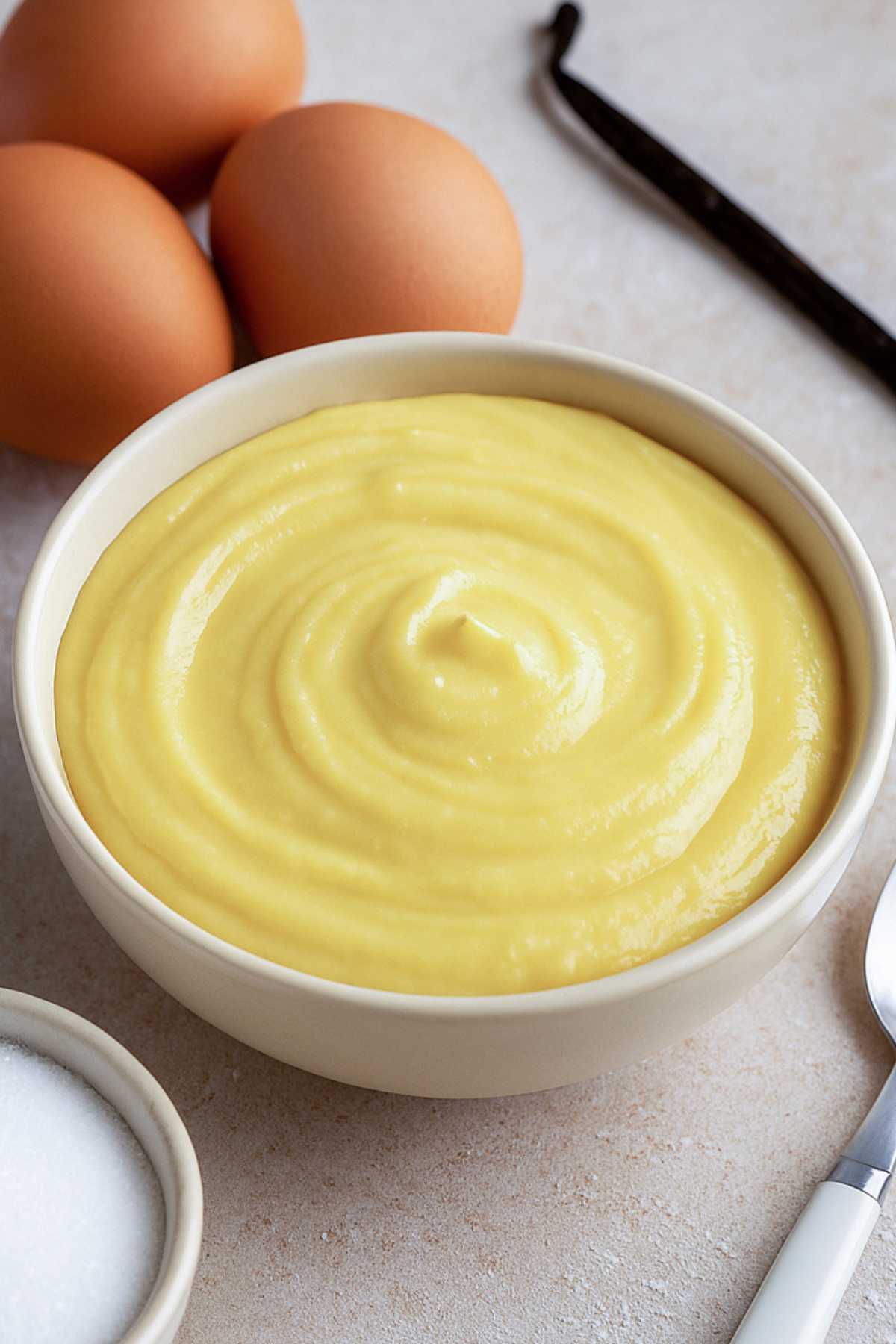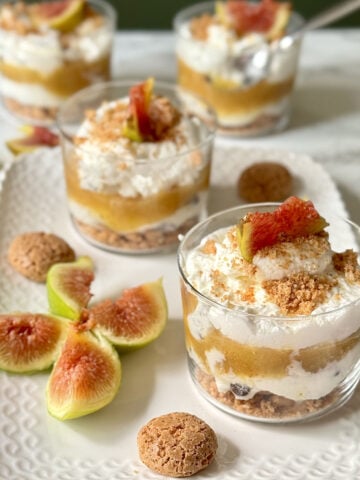Italian Pastry Cream (Crema Pasticcera) is a smooth and velvety custard made with milk, egg yolks, sugar, and a little flour or cornstarch. Flavored with vanilla, lemon, or orange zest, it is one of the most essential preparations in traditional Italian baking.
This classic cream is the filling you’ll find inside many Italian pastries such as cornetti (Italian croissants), bomboloni (doughnuts), cream puffs, fruit tarts, and layer cakes. It’s also used as a base for other desserts, making it one of the most versatile recipes in Italian pastry.

The ingredients are simple, but technique matters. Use fresh whole milk for richness, only egg yolks (never the whites, which can affect texture and flavor), and cook gently to avoid any hint of scrambled egg taste. The result should be a glossy cream with the right balance of thickness, flavor, and smoothness.
Italian pastry cream is so delicious that it can even be served on its own as a spoon dessert, paired with seasonal fruit or crunchy cookies.
Follow this step-by-step recipe to learn how to make authentic Italian pastry cream at home, just like in an Italian pasticceria!
Jump to:
Ingredients

Prep Time: 15 Min | Cook Time: 5 Min | Servings: 4
- 4 medium egg yolks
- 80 g (~⅓ cup) granulated sugar
- 40 g (⅓ cup) all purpose flour
- 500 ml (2 cups) whole fresh milk
- ½ teaspoon vanilla bean or zest of half lemon
Instructions

Step 1) - To prepare authentic Italian pastry cream, place the egg yolks and sugar in a medium saucepan. Stir with a wooden spoon or whisk until the mixture is smooth and pale. Gradually sift in the flour, a little at a time, and keep mixing to avoid lumps.

Step 2) - Continue stirring until everything is well combined and creamy. Set the mixture aside.

Step 3) - In a separate saucepan, heat the milk with vanilla or grated lemon zest, depending on your taste. Bring the milk just to a boil, then remove it from the heat. Slowly pour the hot milk into the egg mixture, whisking constantly.

Step 4) - Return the saucepan to the stove over very low heat. Stir continuously and cook for about 3 to 4 minutes, until the cream thickens. The most important rule: never let the cream boil. If you have a kitchen thermometer, keep the temperature below 85°C (185°F). If bubbles start to appear, lower the heat immediately or lift the pan off the stove for a few seconds, then continue cooking gently.
Once the pastry cream reaches the right consistency, smooth and glossy, pour it immediately into a cold bowl to stop the cooking process.
Your Italian pastry cream (crema pasticcera) is ready! Serve it as a spoon dessert with fruit or cookies, or use it as a filling for cakes, tarts, cream puffs, or traditional Italian pastries like bomboloni and cornetti.

Storage
Before storing, let the Italian pastry cream (crema pasticcera) cool completely at room temperature. Cover it with plastic wrap (cling film), making sure the wrap touches the surface of the cream. This step is essential to prevent a skin from forming on top.
Once cooled, transfer the pastry cream to the refrigerator. Keep it tightly covered with plastic wrap in direct contact with the cream. Properly stored, it will stay fresh for up to 3 days.
If you need to keep it longer, you can freeze Italian pastry cream. Place it in an airtight container, still covered with cling film, and store it in the freezer for up to 1 month. When ready to use, thaw it slowly in the refrigerator and whisk well to restore its smooth, creamy texture.
Traditional Italian Desserts Made with Pastry Cream
In Italian pastry shops, crema pasticcera (Italian pastry cream) is the heart of countless traditional desserts. You’ll find it inside crispy cannoncini and soft bignè alla crema, as well as in fluffy bomboloni and buttery cornetti.
It’s also the irresistible filling of regional specialties like the creamy Sporcamuss from Puglia, the festive Zeppole di San Giuseppe, the famous Pasticciotto from Lecce, the beloved Torta della Nonna with pine nuts and shortcrust pastry and finally the tortelli di carnevale.
This versatile cream is what gives these pastries their unmistakable flavor, making it a symbol of Italian baking tradition.

Variations
There are many delicious variations of Italian pastry cream.
For chocolate lovers, you can enrich it with melted dark chocolate or a couple of tablespoons of unsweetened cocoa powder, creating a smooth and intense dark chocolate pastry cream.
A gluten-free version is also easy to make by replacing the flour with rice starch for a softer cream or cornstarch for a firmer texture.
Those with a sweet tooth may prefer white chocolate pastry cream, made by blending melted white chocolate into the base, perfect for fruit tarts and elegant desserts.
Some pastry chefs also add a splash of whipping cream or a small knob of butter, although these ingredients are not part of the traditional recipe. They help extend the shelf life slightly, add richness, and give the cream a glossy finish. However, even with these additions, Italian pastry cream should be consumed within a few days to fully enjoy its fresh, delicate flavor.
Other Authentic Italian Cream Recipes
- Zabaglione – A classic Italian custard made with egg yolks, sugar, and Marsala wine, light and foamy.
- Diplomat Cream – A rich blend of pastry cream and whipped cream, often used in elegant Italian desserts.
- Italian Lemon Cream – Bright and refreshing, perfect as a filling for tarts or served with fresh fruit.
- Mascarpone Cream – Velvety and rich, famously used as the filling for traditional tiramisu.
- Pistachio Cream – A smooth and flavorful custard made with pistachios, delicious in pastries and cakes.
- Chocolate Pastry Cream – A luscious variation of the classic pastry cream, flavored with rich dark chocolate.

Origins of Italian Pastry Cream
Italian pastry cream, or crema pasticcera, shares its roots with the French crème pâtissière, a custard created in the 17th century and later codified by the famous French chef Marie-Antoine Carême.
In Italy, this cream quickly became a cornerstone of traditional pastry, used to fill tarts, cakes, and pastries found in every pasticceria.
While the French version often serves as a base for more elaborate creams, the Italian crema pasticcera is prized for its simplicity, smooth texture, and delicate flavor. It is considered one of the “madri” (mother creams) of Italian pastry, forming the foundation of many classic desserts.
FAQs
In Italian, pastry cream is called crema pasticcera. It’s one of the fundamental creams in Italian pastry making, used to fill cakes, tarts, and many traditional desserts.
Both Italian crema pasticcera and French crème pâtissière are custards made with milk, sugar, and egg yolks. The main difference is in how they are used: in France it’s often a base for other creams (like diplomat cream), while in Italy it’s more often used on its own as the filling for pastries such as bomboloni, cannoncini, and torta della nonna.
Not exactly. Italian pastry cream is a type of custard, but it is thicker and made with flour or cornstarch for stability. The word “custard” can also refer to desserts like baked flan or even zabaglione, so calling it “pastry cream” is the most accurate term when talking about Italian baking.

Recipe Card

Crema Pasticcera (Italian Pastry Cream Recipe)
Ingredients
- 4 medium egg yolks
- 80 g granulated sugar - ~⅓ cup
- 40 g all-purpose flour - ⅓ cup
- 500 ml milk - 2 cups
- ½ teaspoon vanilla bean or half lemon zest
Instructions
- Place the egg yolks and sugar in a medium saucepan. Stir with a wooden spoon or whisk until the mixture is smooth and pale.
- Gradually sift in the flour, a little at a time, and keep mixing to avoid lumps. Continue stirring until everything is well combined and creamy. Set the mixture aside.
- In a separate saucepan, heat the milk with vanilla or grated lemon zest, depending on your taste. Bring the milk just to a boil, then remove it from the heat.
- Slowly pour the hot milk into the egg mixture, whisking constantly.
- Return the saucepan to the stove over very low heat. Stir continuously and cook for about 3 to 4 minutes, until the cream thickens. The most important rule: never let the cream boil. If you have a kitchen thermometer, keep the temperature below 85°C (185°F). If bubbles start to appear, lower the heat immediately or lift the pan off the stove for a few seconds, then continue cooking gently.
- Once the pastry cream reaches the right consistency, smooth and glossy, pour it immediately into a cold bowl to stop the cooking process.





Jessy says
I tried this Italian Pastry Cream recipe and it turned out perfect! The cream was silky, glossy, and full of flavor, just like the one I tasted in Italy. I used it in a fruit tart, and everyone loved it. The step-by-step instructions were clear, and I really appreciated the tips on how to avoid lumps. This is now my go-to recipe!